fuel KIA QUORIS 2013 Owners Manual
[x] Cancel search | Manufacturer: KIA, Model Year: 2013, Model line: QUORIS, Model: KIA QUORIS 2013Pages: 485, PDF Size: 31.55 MB
Page 4 of 485
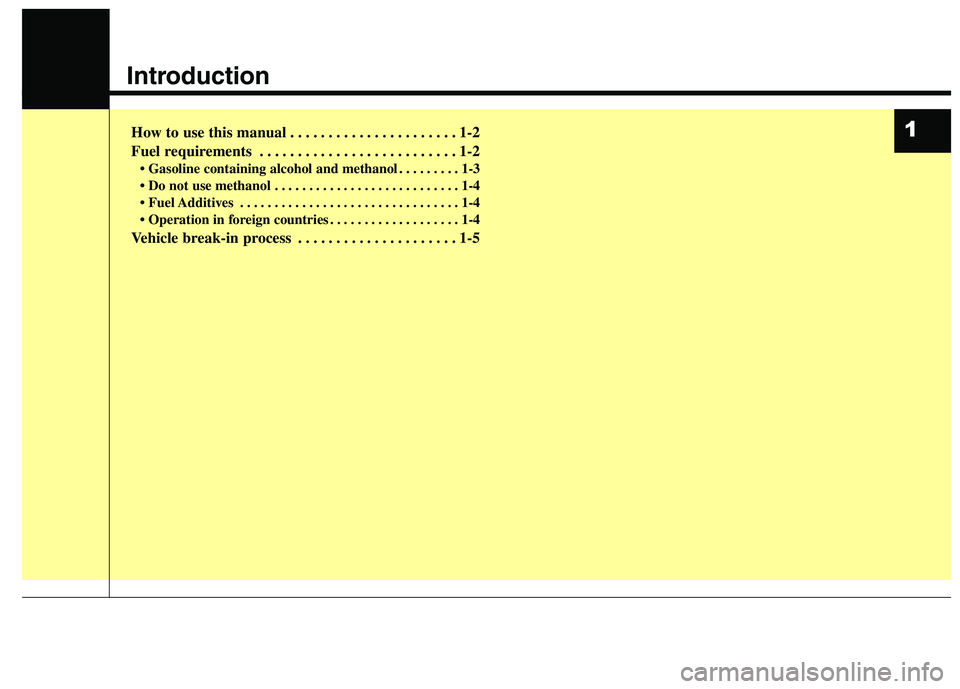
Introduction
How to use this manual . . . . . . . . . . . . . . . . . . . . . . 1-2
Fuel requirements . . . . . . . . . . . . . . . . . . . . . . . . . . 1-2⢠Gasoline containing alcohol and methanol . . . . . . . . . 1-3
. . . . . . . . . . . . . . . . . . . . . . . . . . . 1-4
. . . . . . . . . . . . . . . . . . . . . . . . . . . . . . . . 1-4
. . . . . . . . . . . . . . . . . . . 1-4
Vehicle break-in process . . . . . . . . . . . . . . . . . . . . . 1-51
Page 5 of 485
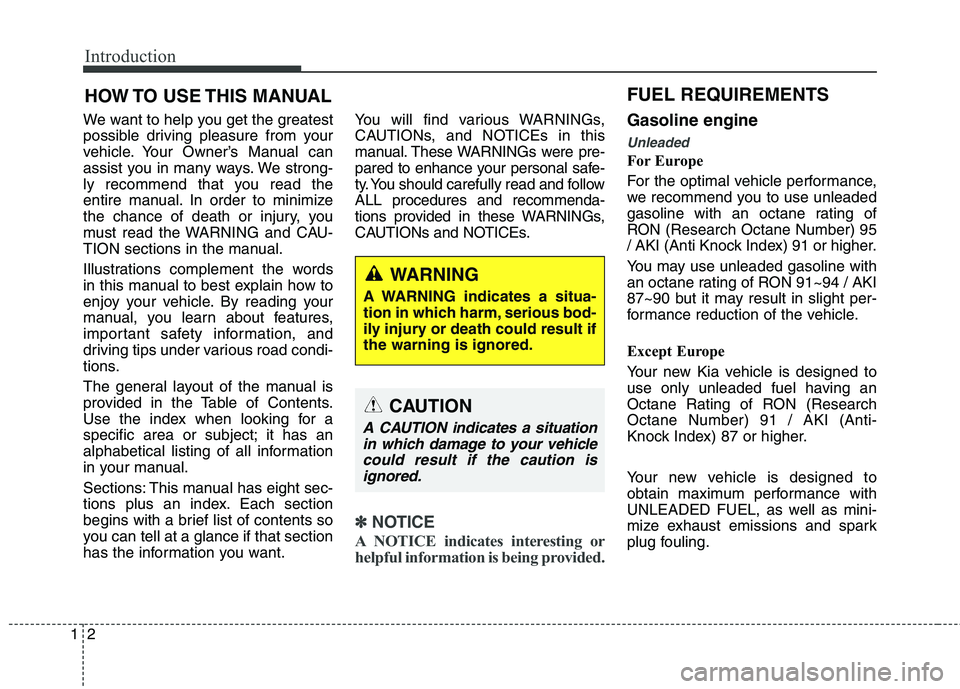
Introduction
2
1
We want to help you get the greatest
possible driving pleasure from your
vehicle. Your Ownerâs Manual can
assist you in many ways. We strong-
ly recommend that you read the
entire manual. In order to minimize
the chance of death or injury, you
must read the WARNING and CAU-
TION sections in the manual.
Illustrations complement the words
in this manual to best explain how to
enjoy your vehicle. By reading your
manual, you learn about features,
important safety information, and
driving tips under various road condi-
tions.
The general layout of the manual is
provided in the Table of Contents.
Use the index when looking for a
specific area or subject; it has an
alphabetical listing of all information
in your manual.
Sections: This manual has eight sec-
tions plus an index. Each section
begins with a brief list of contents so
you can tell at a glance if that section
has the information you want. You will find various WARNINGs,
CAUTIONs, and NOTICEs in this
manual. These WARNINGs were pre-
pared to enhance your personal safe-
ty. You should carefully read and followALL procedures and recommenda-
tions provided in these WARNINGs,
CAUTIONs and NOTICEs.
â˝â˝
NOTICE
A NOTICE indicates interesting or
helpful information is being provided.
Gasoline engine
Unleaded
For Europe
For the optimal vehicle performance,
we recommend you to use unleaded
gasoline with an octane rating of
RON (Research Octane Number) 95
/ AKI (Anti Knock Index) 91 or higher.
You may use unleaded gasoline with
an octane rating of RON 91~94 / AKI
87~90 but it may result in slight per-
formance reduction of the vehicle.
Except Europe
Your new Kia vehicle is designed to
use only unleaded fuel having an
Octane Rating of RON (ResearchOctane Number) 91 / AKI (Anti-
Knock Index) 87 or higher.
Your new vehicle is designed to
obtain maximum performance with
UNLEADED FUEL, as well as mini-
mize exhaust emissions and spark
plug fouling.
HOW TO USE THIS MANUAL
WARNING
A WARNING indicates a situa-
tion in which harm, serious bod-
ily injury or death could result ifthe warning is ignored.
CAUTION
A CAUTION indicates a situation in which damage to your vehiclecould result if the caution is ignored.
FUEL REQUIREMENTS
Page 6 of 485
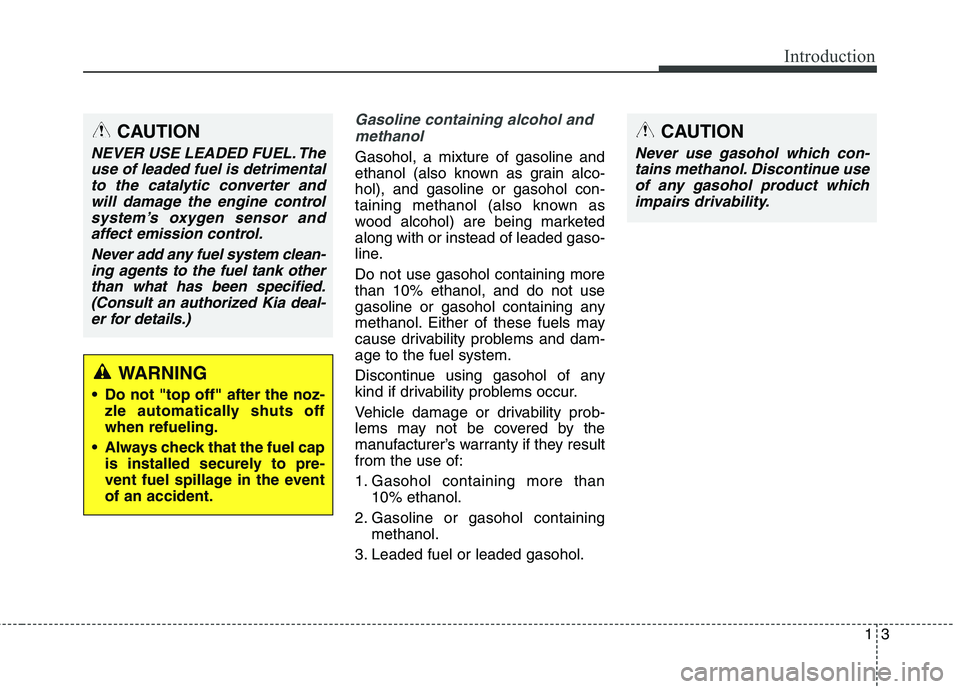
13
Introduction
Gasoline containing alcohol andmethanol
Gasohol, a mixture of gasoline and
ethanol (also known as grain alco-hol), and gasoline or gasohol con-
taining methanol (also known as
wood alcohol) are being marketedalong with or instead of leaded gaso-
line. Do not use gasohol containing more than 10% ethanol, and do not use
gasoline or gasohol containing any
methanol. Either of these fuels may
cause drivability problems and dam-age to the fuel system.
Discontinue using gasohol of any
kind if drivability problems occur.
Vehicle damage or drivability prob-
lems may not be covered by the
manufacturerâs warranty if they resultfrom the use of:
1. Gasohol containing more than 10% ethanol.
2. Gasoline or gasohol containing methanol.
3. Leaded fuel or leaded gasohol.
WARNING
⢠Do not "top off" after the noz- zle automatically shuts off when refueling.
Always check that the fuel cap is installed securely to pre-
vent fuel spillage in the eventof an accident.
CAUTION
NEVER USE LEADED FUEL. The
use of leaded fuel is detrimentalto the catalytic converter and will damage the engine controlsystemâs oxygen sensor andaffect emission control.
Never add any fuel system clean-ing agents to the fuel tank other than what has been specified.(Consult an authorized Kia deal-er for details.)
CAUTION
Never use gasohol which con- tains methanol. Discontinue useof any gasohol product whichimpairs drivability.
Page 7 of 485
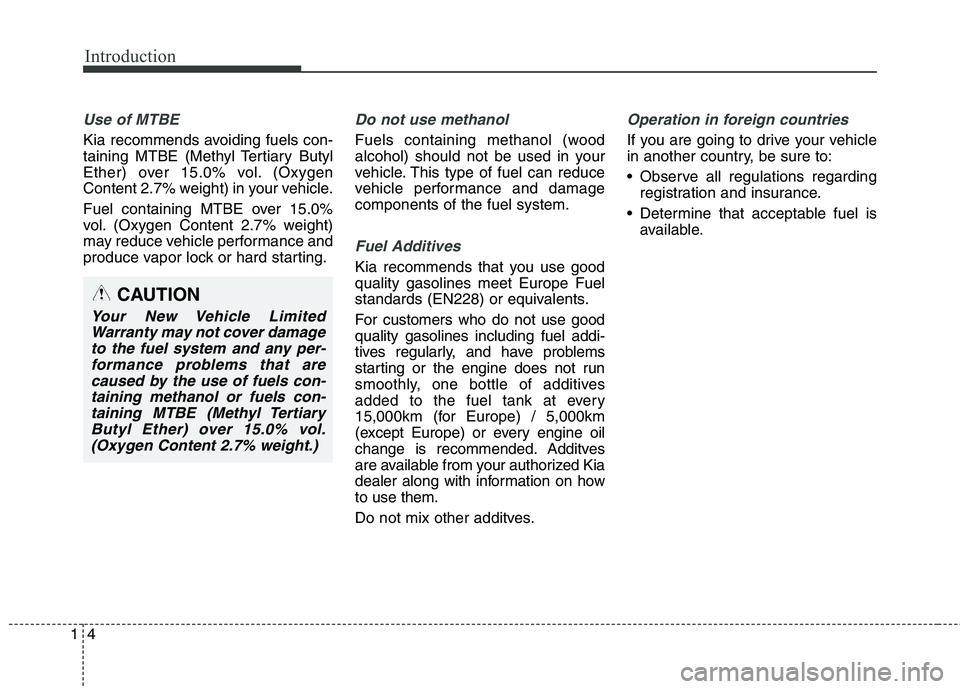
Introduction
4
1
Use of MTBE
Kia recommends avoiding fuels con-
taining MTBE (Methyl Tertiary Butyl
Ether) over 15.0% vol. (Oxygen
Content 2.7% weight) in your vehicle.
Fuel containing MTBE over 15.0%
vol. (Oxygen Content 2.7% weight)
may reduce vehicle performance and
produce vapor lock or hard starting.
Do not use methanol
Fuels containing methanol (wood
alcohol) should not be used in your
vehicle. This type of fuel can reduce
vehicle performance and damagecomponents of the fuel system.
Fuel Additives
Kia recommends that you use good quality gasolines meet Europe Fuel
standards (EN228) or equivalents.
For customers who do not use good quality gasolines including fuel addi-
tives regularly, and have problems
starting or the engine does not run
smoothly, one bottle of additives
added to the fuel tank at every
15,000km (for Europe) / 5,000km
(except Europe) or every engine oil
change is recommended. Additves
are available from your authorized Kia
dealer along with information on howto use them.
Do not mix other additves.
Operation in foreign countries
If you are going to drive your vehicle
in another country, be sure to:
Observe all regulations regarding
registration and insurance.
Determine that acceptable fuel is available.
CAUTION
Your New Vehicle Limited
Warranty may not cover damageto the fuel system and any per- formance problems that arecaused by the use of fuels con-taining methanol or fuels con- taining MTBE (Methyl TertiaryButyl Ether) over 15.0% vol.(Oxygen Content 2.7% weight.)
Page 11 of 485

23
Your vehicle at a glance
9. Door.......................................................4-15
10. Fuel filler lid .........................................4-34
11. Rear combination lamp .......................7-75
12. Trunk lid ...............................................4-20
13. High mounted stop lamp .....................7-76
14. Rear window defroster ......................4-127
15. Rear parking assist system .................4-99
16. Antenna .............................................4-163
17. Rearview camera ..............................4-104OKH012002
â Rear view
âThe actual shape may differ from the illustration.
Page 12 of 485
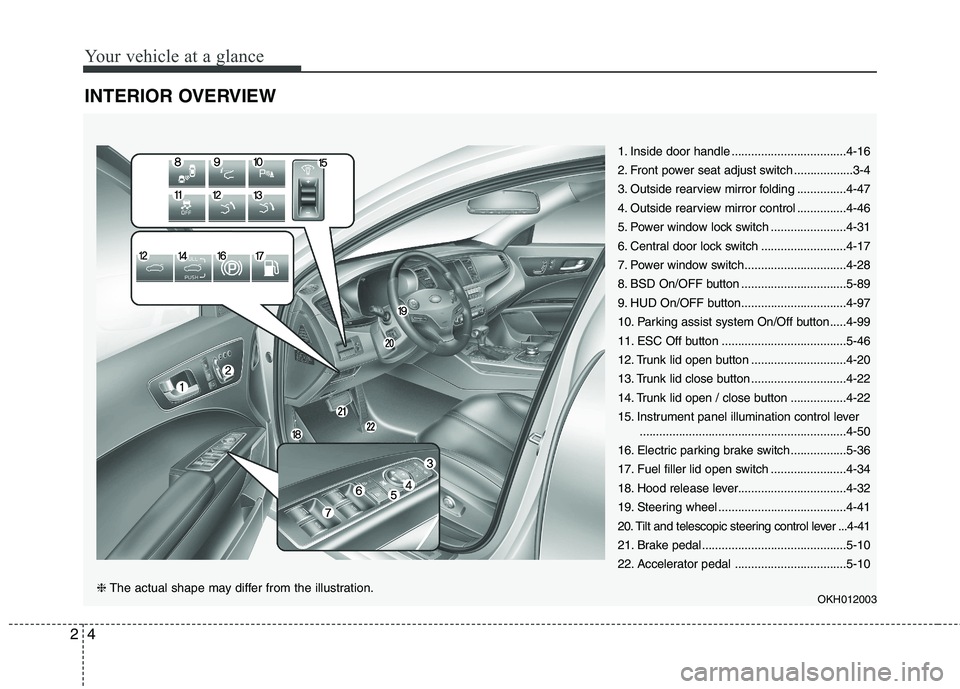
Your vehicle at a glance
4
2
INTERIOR OVERVIEW
1. Inside door handle ...................................4-16
2. Front power seat adjust switch ..................3-4
3. Outside rearview mirror folding ...............4-47
4. Outside rearview mirror control ...............4-46
5. Power window lock switch .......................4-31
6. Central door lock switch ..........................4-17
7. Power window switch...............................4-28
8. BSD On/OFF button ................................5-89
9. HUD On/OFF button................................4-97
10. Parking assist system On/Off button.....4-99
11. ESC Off button ......................................5-46
12. Trunk lid open button .............................4-20
13. Trunk lid close button .............................4-22
14. Trunk lid open / close button .................4-22
15. Instrument panel illumination control lever
...............................................................4-50
16. Electric parking brake switch .................5-36
17. Fuel filler lid open switch .......................4-34
18. Hood release lever.................................4-32
19. Steering wheel .......................................4-41
20. Tilt and telescopic steering control lever ...4-41
21. Brake pedal............................................5-10
22. Accelerator pedal ..................................5-10
OKH012003
âThe actual shape may differ from the illustration.
Page 80 of 485
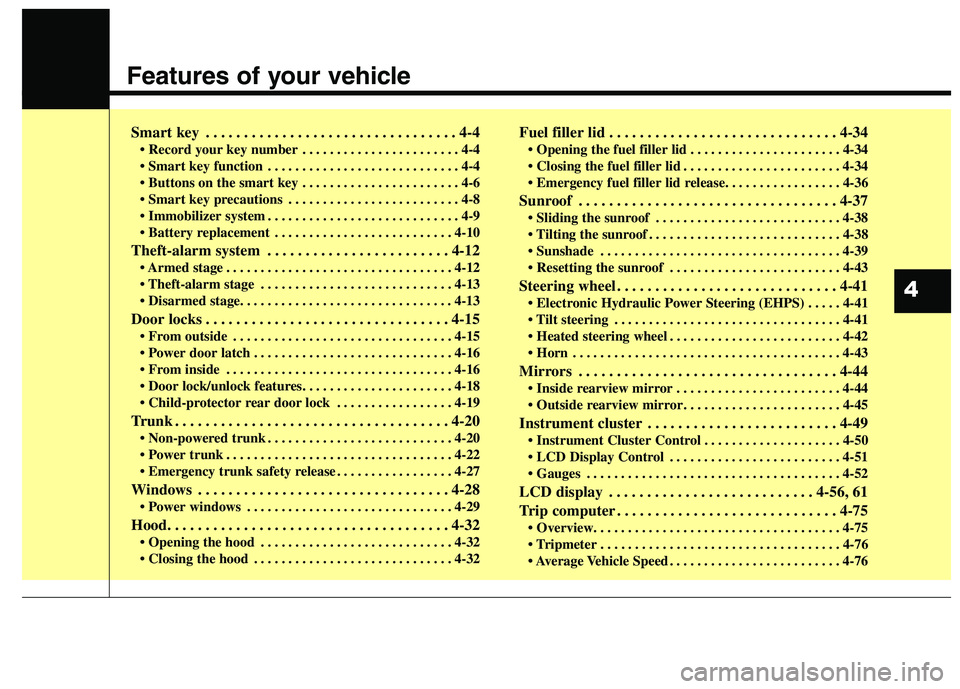
Features of your vehicle
Smart key . . . . . . . . . . . . . . . . . . . . . . . . . . . . . . . . . 4-4⢠Record your key number . . . . . . . . . . . . . . . . . . . . . . . 4-4
. . . . . . . . . . . . . . . . . . . . . . . . . . . . 4-4
. . . . . . . . . . . . . . . . . . . . . . . 4-6
. . . . . . . . . . . . . . . . . . . . . . . . . 4-8
. . . . . . . . . . . . . . . . . . . . . . . . . . . . 4-9
. . . . . . . . . . . . . . . . . . . . . . . . . . 4-10
Theft-alarm system . . . . . . . . . . . . . . . . . . . . . . . . 4-12 . . . . . . . . . . . . . . . . . . . . . . . . . . . . . . . . . 4-12
. . . . . . . . . . . . . . . . . . . . . . . . . . . . 4-13
Door locks . . . . . . . . . . . . . . . . . . . . . . . . . . . . . . . . 4-15 . . . . . . . . . . . . . . . . . . . . . . . . . . . . . . . . 4-15
. . . . . . . . . . . . . . . . . . . . . . . . . . . . . 4-16
. . . . . . . . . . . . . . . . . . . . . . . . . . . . . . . . . 4-16
. . . . . . . . . . . . . . . . . 4-19
Trunk . . . . . . . . . . . . . . . . . . . . . . . . . . . . . . . . . . . . 4-20 . . . . . . . . . . . . . . . . . . . . . . . . . . . 4-20
. . . . . . . . . . . . . . . . . . . . . . . . . . . . . . . . . 4-22
. . . . . . . . . . . . . . . . . 4-27
Windows . . . . . . . . . . . . . . . . . . . . . . . . . . . . . . . . . 4-28 . . . . . . . . . . . . . . . . . . . . . . . . . . . . . . 4-29
Hood. . . . . . . . . . . . . . . . . . . . . . . . . . . . . . . . . . . . . 4-32 . . . . . . . . . . . . . . . . . . . . . . . . . . . . 4-32
. . . . . . . . . . . . . . . . . . . . . . . . . . . . . 4-32 Fuel filler lid . . . . . . . . . . . . . . . . . . . . . . . . . . . . . . 4-34
. . . . . . . . . . . . . . . . . . . . . . 4-34
. . . . . . . . . . . . . . . . . . . . . . . 4-34
Sunroof . . . . . . . . . . . . . . . . . . . . . . . . . . . . . . . . . . 4-37 . . . . . . . . . . . . . . . . . . . . . . . . . . . 4-38
. . . . . . . . . . . . . . . . . . . . . . . . . . . . 4-38
. . . . . . . . . . . . . . . . . . . . . . . . . . . . . . . . . . . 4-39
. . . . . . . . . . . . . . . . . . . . . . . . . 4-43
Steering wheel . . . . . . . . . . . . . . . . . . . . . . . . . . . . . 4-41 . . . . . 4-41
. . . . . . . . . . . . . . . . . . . . . . . . . . . . . . . . . 4-41
. . . . . . . . . . . . . . . . . . . . . . . . . 4-42
. . . . . . . . . . . . . . . . . . . . . . . . . . . . . . . . . . . . . . . 4-43
Mirrors . . . . . . . . . . . . . . . . . . . . . . . . . . . . . . . . . . 4-44 . . . . . . . . . . . . . . . . . . . . . . . . 4-44
. . . . . . . . . . . . . . . . . . . . . . . 4-45
Instrument cluster . . . . . . . . . . . . . . . . . . . . . . . . . 4-49 . . . . . . . . . . . . . . . . . . . . 4-50
. . . . . . . . . . . . . . . . . . . . . . . . . 4-51
. . . . . . . . . . . . . . . . . . . . . . . . . . . . . . . . . . . . . 4-52
LCD display . . . . . . . . . . . . . . . . . . . . . . . . . . . 4-56, 61
Trip computer . . . . . . . . . . . . . . . . . . . . . . . . . . . . . 4-75
. . . . . . . . . . . . . . . . . . . . . . . . . . . . . . . . . . . 4-76
. . . . . . . . . . . . . . . . . . . . . . . . . 4-76
4
Page 113 of 485
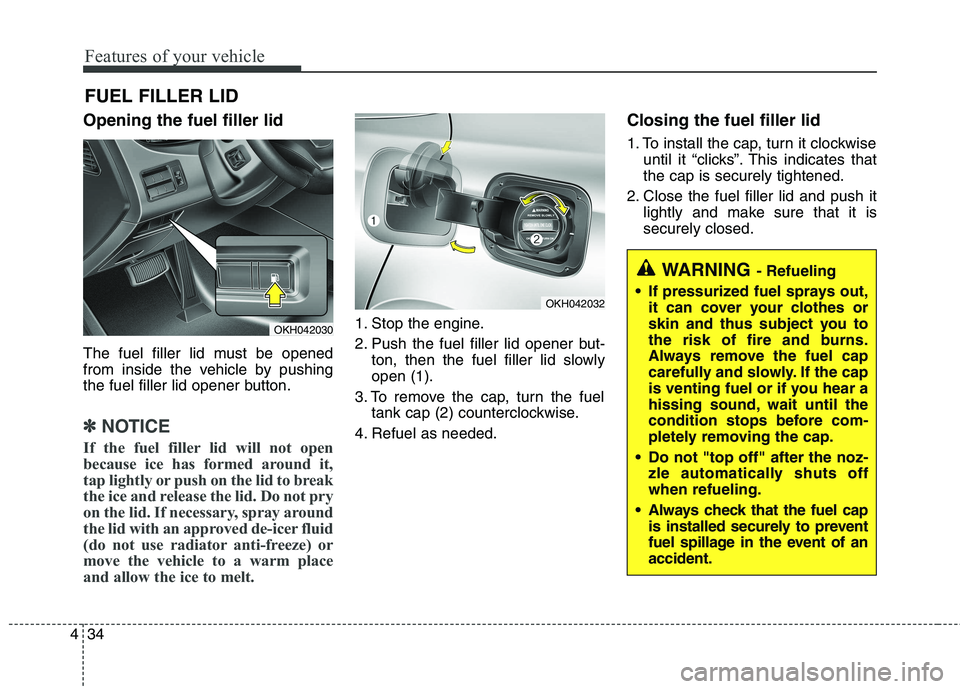
Features of your vehicle
34
4
Opening the fuel filler lid
The fuel filler lid must be opened
from inside the vehicle by pushing
the fuel filler lid opener button.
â˝â˝
NOTICE
If the fuel filler lid will not open
because ice has formed around it,
tap lightly or push on the lid to break
the ice and release the lid. Do not pry
on the lid. If necessary, spray around
the lid with an approved de-icer fluid
(do not use radiator anti-freeze) or
move the vehicle to a warm place
and allow the ice to melt.
1. Stop the engine.
2. Push the fuel filler lid opener but- ton, then the fuel filler lid slowly open (1).
3. To remove the cap, turn the fuel tank cap (2) counterclockwise.
4. Refuel as needed. Closing the fuel filler lid
1. To install the cap, turn it clockwise
until it âclicksâ. This indicates that the cap is securely tightened.
2. Close the fuel filler lid and push it lightly and make sure that it issecurely closed.
FUEL FILLER LID OKH042030
OKH042032
WARNING
- Refueling
If pressurized fuel sprays out, it can cover your clothes or
skin and thus subject you to
the risk of fire and burns.
Always remove the fuel cap
carefully and slowly. If the cap
is venting fuel or if you hear a
hissing sound, wait until the
condition stops before com-
pletely removing the cap.
Do not "top off" after the noz- zle automatically shuts offwhen refueling.
Always check that the fuel cap is installed securely to prevent
fuel spillage in the event of anaccident.
Page 114 of 485
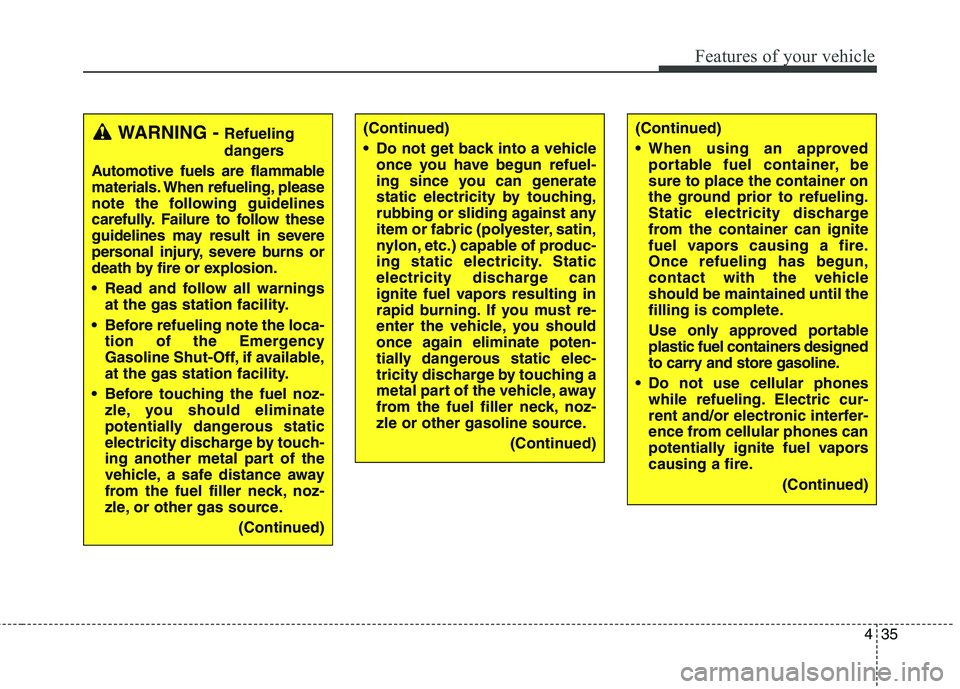
435
Features of your vehicle
(Continued)
Do not get back into a vehicleonce you have begun refuel-
ing since you can generate
static electricity by touching,
rubbing or sliding against any
item or fabric (polyester, satin,
nylon, etc.) capable of produc-
ing static electricity. Static
electricity discharge can
ignite fuel vapors resulting in
rapid burning. If you must re-
enter the vehicle, you should
once again eliminate poten-
tially dangerous static elec-
tricity discharge by touching a
metal part of the vehicle, away
from the fuel filler neck, noz-
zle or other gasoline source.
(Continued)WARNING - Refueling
dangers
Automotive fuels are flammable
materials. When refueling, please
note the following guidelines
carefully. Failure to follow these
guidelines may result in severe
personal injury, severe burns or
death by fire or explosion.
Read and follow all warnings at the gas station facility.
Before refueling note the loca- tion of the Emergency
Gasoline Shut-Off, if available,
at the gas station facility.
Before touching the fuel noz- zle, you should eliminate
potentially dangerous static
electricity discharge by touch-
ing another metal part of the
vehicle, a safe distance away
from the fuel filler neck, noz-
zle, or other gas source.
(Continued)(Continued)
When using an approvedportable fuel container, be sure to place the container on
the ground prior to refueling.
Static electricity discharge
from the container can ignite
fuel vapors causing a fire.Once refueling has begun,
contact with the vehicleshould be maintained until the
filling is complete.
Use only approved portable
plastic fuel containers designed
to carry and store gasoline.
Do not use cellular phones while refueling. Electric cur-
rent and/or electronic interfer-
ence from cellular phones can
potentially ignite fuel vapors
causing a fire.
(Continued)
Page 115 of 485
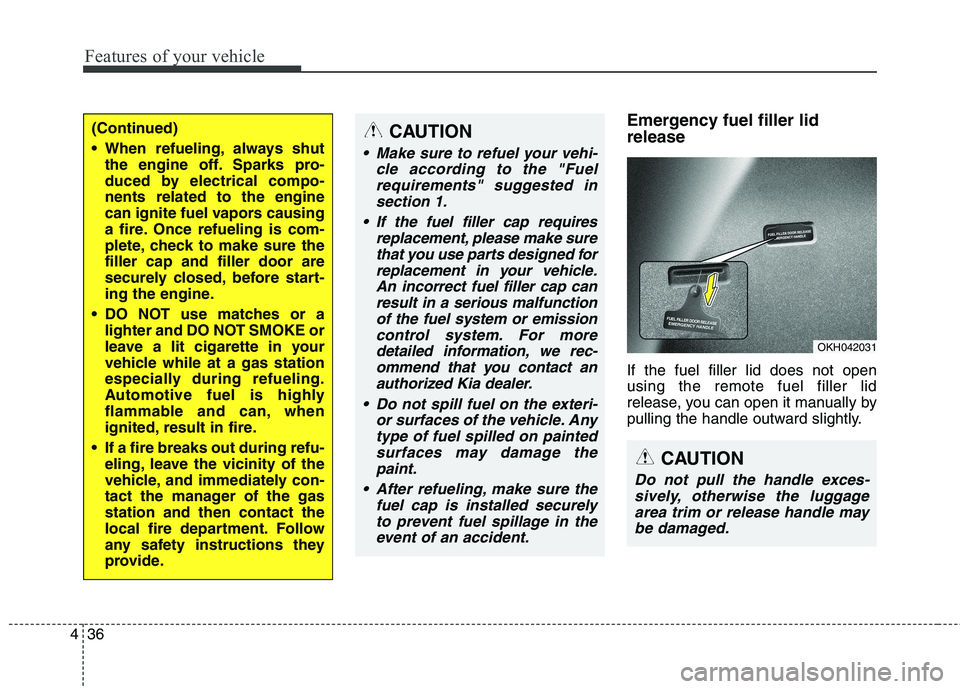
Features of your vehicle
36
4
Emergency fuel filler lid release If the fuel filler lid does not open using the remote fuel filler lid
release, you can open it manually by
pulling the handle outward slightly.(Continued)
When refueling, always shut
the engine off. Sparks pro-
duced by electrical compo-nents related to the engine
can ignite fuel vapors causing
a fire. Once refueling is com-
plete, check to make sure thefiller cap and filler door are
securely closed, before start-
ing the engine.
DO NOT use matches or a lighter and DO NOT SMOKE or
leave a lit cigarette in your
vehicle while at a gas station
especially during refueling.
Automotive fuel is highly
flammable and can, when
ignited, result in fire.
If a fire breaks out during refu- eling, leave the vicinity of the
vehicle, and immediately con-
tact the manager of the gasstation and then contact the
local fire department. Follow
any safety instructions they
provide.CAUTION
Make sure to refuel your vehi-
cle according to the "Fuelrequirements" suggested insection 1.
If the fuel filler cap requires replacement, please make surethat you use parts designed for replacement in your vehicle.An incorrect fuel filler cap canresult in a serious malfunction of the fuel system or emissioncontrol system. For moredetailed information, we rec-ommend that you contact an authorized Kia dealer.
Do not spill fuel on the exteri- or surfaces of the vehicle. Anytype of fuel spilled on paintedsurfaces may damage the paint.
After refueling, make sure the fuel cap is installed securelyto prevent fuel spillage in theevent of an accident.
CAUTION
Do not pull the handle exces-sively, otherwise the luggagearea trim or release handle may be damaged.
OKH042031